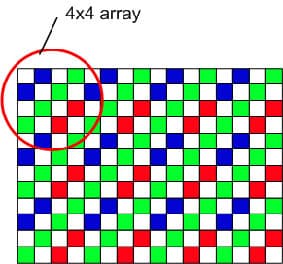A ‘sample’ of Kodak’s new image sensor will be available in ‘the first quarter of 2008’, according to Kodak?s US office.
‘Once that is available some additional time will be needed by camera manufacturers to design, develop and manufacture a camera using this sensor,’ added co-inventor John Compton.
However, no-one from Kodak?s UK office was willing to comment on the US-developed technology, which was unveiled yesterday.
The sensor?s US inventors said they spent ‘several years’ developing the technology, which they claim, increases sensitivity to light by up to 4x.
Kodak scientists say the new technology will enable photographers to use faster shutter speeds and ?cut down on camera shake?.
Key to the new sensor is the layout, which adds panchromatic pixels to the red, green and blue elements that characterise the arrangement in a traditional Bayer Pattern sensor.
‘In the original Bayer design the green pixels are used to recover most of the luminance information from the image,’ explained John Hamilton who helped develop the technology.
‘Now, we are using panchromatic pixels ? which are more sensitive than green pixels because none of the photons get filtered out or wasted ? to act as the luminance. This gives us a more sensitive luminance channel in the final image which raises the sensitivity of the entire sensor,’ he claimed.
Hamilton added: ‘In a low-light situation these new patterns will produce a lot less colour noise than a Bayer pattern sensor.’
Commenting on the move, AP Editor Damien Demolder said: ‘In this new design it seems that Kodak is boosting the sensor?s ability to draw a subject, while the usual filtered pixels are there to do the colouring in.’
Damien added: ‘It’s a new idea in sensor design but actually mirrors the workings of many firmware based anti-shake systems that capture colour and luminance separately via a double exposure. As this sensor is said to capture colour and enhanced luminance at the same time, it should present a more useful solution. I would expect overall noise to be reduced by this technology at high ISO settings, but we will have to wait and see what the effect will be on colour rendition.’
Though the new technology has yet to be introduced into any camera, Kodak said it has already begun developing CMOS sensors using it for use in consumer products such as digital still cameras and camera phones.
The company points out that the technology can also be used in CCD imaging sensors and targeted at markets including industrial and scientific imaging products.
To this end Kodak has developed several patterns, according to the levels of image processing that may be required for different applications, for example.
A full report on the technology will appear in a forthcoming issue of AP.
For our story yesterday on this see here:










